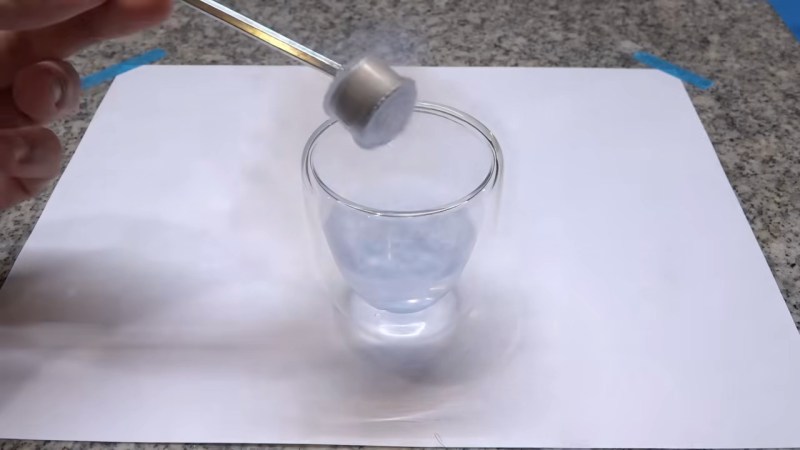Normally, videos over at The Signal Path channel on YouTube have a certain vibe, namely teardowns and deep dives into high-end test equipment for the microwave realm. And while we always love to see that kind of content, this hop into the world of cryogenics and liquid oxygen production shows that [Shahriar] has other interests, too.
Of course, to make liquid oxygen, one must first have oxygen. While it would be easy enough to get a tank of the stuff from a gas supplier, where’s the fun in that? So [Shahriar] started his quest with a cheap-ish off-the-shelf oxygen concentrator, one that uses the pressure-swing adsorption cycle we saw used to great effect with DIY O2 concentrators in the early days of the pandemic. Although analysis of the machine’s output revealed it wasn’t quite as capable as advertised, it still put out enough reasonably pure oxygen for the job at hand.
The next step in making liquid oxygen is cooling it, and for that job [Shahriar] turned to the cryocooler from a superconducting RF filter, a toy we’re keen to see more about in the future. For now, he was able to harvest the Stirling-cycle cryocooler and rig it up in a test stand with ample forced-air cooling for the heat rejection end and a manifold to supply a constant flow of oxygen from the concentrator. Strategically placed diodes were used to monitor the temperature at the cold end, a technique we can’t recall seeing before. Once powered up, the cryocooler got down to the 77 Kelvin range quite quickly, and within an hour, [Shahriar] had at least a hundred milliliters of lovely pale blue fluid that passed all the usual tests.
While we’ve seen a few attempts to make liquid nitrogen before, this might be the first time we’ve seen anyone make liquid oxygen. Hats off to [Shahriar] for the effort.
















next step is to create liquid o² injectors for a drag race motor…,……….
….no intake side….
It sounds like a great idea but directly using oxygen isn’t safe. It’s too unstable,
if anything goes wrong(TM), there isn’t a driver or a car anymore. Besides that, using pure oxygen instead of nitro means that the engine will heat up quicker, makingif anything goes wrong(TM) happen much more frequently and much more violent. Nitro splits up and during that, it cools the engine. If pure oxygen was safe and stable, it would have been used by every team for the last few decades. There have been attempts becauseit works here(TM) means that if it doesn’t go wrong, you get insane power. Take the 8k-12k horsepower top fuel usually makes and you can probably double it.It worksorit doesn't workandit doesn't workis usually catastrophic.(I did not realize that hackaday accepted markdown formatting, this formatting was not my intention)
we got ourselves a real bobby bummer over here
(please forgive me)
Don’t know what to forgive you for as I have no clue what that means.
Pure oxygen may cause corrosion in combustion engines which is why exhaust gas is mixed with the oxygen. This method has been used in non-nuclear submarines to run diesel engine while under the surface.
If you stick a coronal dischage ozone generator tube and another pressure swing absorption setup in the path, you can generate relatively pure liquid ozone.
That might be in Derek Lowe’s list of “Things I Won’t Work With”, e.g. https://www.science.org/content/blog-post/things-i-won-t-work-dioxygen-difluoride.
O3 is toxic and lung-rotting enough in the dilute gas phase, not to mention the liquid’s ability to decompose rapidly and unexpectedly.
It’s about asking if we COULD, not if we SHOULD.
Things on his list are usually way way worse.
there are videos of fairly pure liquid ozone decomposing…in slow motion… “decompose rapidly” is a little too mild description of the violent detonation depicted
Not really the safest stuff to play with. So easy to immolate something by accident.
At one of my previous workplaces we got regular liquid oxygen deliveries, about 20 tons weekly, in early morning before sunrise (so, low wind, no thermal convection). I was on call many of those mornings so got to see the process pretty often.
One delivery driver seemed to think it was hilarious to overfill the giant Dewar and fill the alleyway with fog from the cold oxygen. He’d walk through the foggy waist-deep oxygen pool back to his truck.
I’m astounded he didn’t catch fire from static discharge lighting off his pants in the super-dry oxygen, and wondered what safety training he got. Darwin never got him though, and the building is still standing.
At least he didn’t try to smoke
Looks like that cryocooler cost about $4k. That’s what the most recently sold one on eBay went for (search “SuperLink Rx”) and the sharpie marks on it seem to match those in the video.
Maybe one day…
$4k is about half the price of just the annual service cost for one of ours…
The pale blue color of liquid oxygen is beautiful in real life and is captured well in the photos.
One of my former coworkers had a side gig refilling NMRs with liquid helium. I tagged along one day just for fun. The transfer line gets cold enough that drops of liquid oxygen drip off, pale blue and incredible. I think it is something humans aren’t really used to seeing, like a total solar eclipse or something, and it is really an amazing experience.
It probably goes without saying, but liquid oxygen is an extremely dangerous substance, and will cause the combustion or explosion of what might otherwise seem like innocuous materials (plastic, clothing, asphalt, some metals even) after what might otherwise seem like innocuous events (a bit of friction, a tiny static shock).
To give an example, Air Products (who sells liquefied gases) recommends that any item of clothing that gets LOX spilled on it be removed immediately and allowed to air out for at least an hour.
When my dad was grad student, he amused himself by soaking the end of some rope in LOX, then lit it on fire while spinning it over his head.
I saw the burn mark in the bar table where he dropped it after deciding it was all a bad idea.
Still there, nobody at the bar knew what it was until he told them the story.
Heidelberg.
Back in the paleo-internet days George Goble got (even more) famous for lighting a charcoal grill with a bucket of liquid oxygen. It’s, uh, quick: https://youtu.be/UjPxDOEdsX8
+199 points for George Goble reference. I was just looking for it! Those mad blue eyes…
Liquid nitrogen, now liquid oxygen…now let’s see someone do liquid argon!
Do shots of liquid hydrogen. That’ll light you up for sure!
I had a washing machine that did this for the hot/cold water mixing chamber. It threw me off at first, I couldn’t figure out why a diode was stuck into that space, but after some thinking on it, the only conclusion I could reach was “this must be how they determine the water temperature.”
A quick search and it looks like TI (SBOA277A), Analog (AN137), and a variety of others have written on the subject.
Yep. There have been multiple posts on Hackaday about using diodes as temperature sensors…. https://hackaday.com/2018/04/16/two-cent-temperature-sensors/
That’s how the die temperature sensor works in many processors.
This is the hard way.
Pyromaniacs know a shortcut.
These instructions are so you know exactly what not to do!
Don’t do this:
Get a tank of Liquid Nitrogen.
Attach a length of thin walled copper or aluminum tube to the outlet of the tank (no regulator), angled downward, about a foot long. Put a good glass walled vacuum thermos under the low point, but not right in front of the opening.
Secure the Nitrogen tank, this will make thrust.
Open the tank valve, so the nitrogen is blasting out through the tube.
Liquid air will form on the outside of the tube, dripping into the thermos.
When you have a sufficient quantity of liquid air close the value and put the thermos into the coldest freezer you have access to, no lid. (Assuming you don’t have access to actual cryo temps.)
Wait about 1 week.
Most of the liquid air will have evaporated, what’s left is almost pure LOX.
Basic P-chem.
Old liquid air is LOX.
Not efficient at all, assumes free Nitrogen tanks. (Dad was a Chem prof/pyromaniac, he had ‘free’ Nitrogen tanks.)
Have fun.
Beware LOX is a ‘controlled substance’ in the USA.
Don’t do any of this.
This is not legal advice!